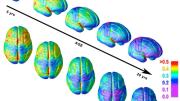Dean Michael D. Smith’s annual report for fiscal year 2012—previewed with Faculty of Arts and Sciences (FAS) colleagues at their October 2 meeting and published two days later—declares victory and outlines a future campaign.
The retrospective victory note concerns the faculty’s finances: after projecting large deficits in the wake of the 2008 financial crisis and sharp decline in the value of the endowment, FAS, as planned, achieved a balanced budget in its “unrestricted Core operations”: the faculty, the Gradate School of Arts and Sciences (GSAS), and the College. But unplanned activities—prominently, launching edX (see "Classroom in the Cloud") and beginning construction for the House renewal program—resulted in a $9.7-million deficit on the same basis. For all FAS activities—including athletics, the library and museums, School of Engineering and Applied Sciences, etc.—the unrestricted deficit was $34.9 million; the consolidated result, including all funds, was $20.5 million of red ink, covered by the use of reserve funds. (All figures are on an FAS management-reporting basis, not in accordance with generally accepted accounting principles.)
Having largely slain the financial dragon, Smith looks toward the next campaign: the University’s forthcoming fundraising drive. Although the report says little about the campaign or FAS’s substantive goals, it suggests two priorities.
Smith emphasizes House renewal (as does Dean Evelynn Hammonds in the Harvard College section). In her October 2 presentation, Leslie Kirwan, dean for administration and finance, made clear what financing that multiyear project, forecast to cost at least $1 billion, will require; she cited endowment funds, philanthropy, FAS reserves, cash from operations, and long-term debt, both “incremental and nonincremental.” The latter has not been invoked since the University became much more cautious about debt in the wake of its 2008 problems, when it had to borrow $2.5 billion.
There is also a section devoted to edX—an element in FAS’s plans to invest in teaching and in applying technology to education, both in the classroom and for online, distance learners.
Other highlights:
- Ebbing humanities and social sciences, rising sciences. During the past decade, the number of undergraduate arts and humanities concentrators peaked at 1,104 in 2003-2004, and has declined steadily, to 823 last year—down 25 percent. The social sciences are down, too—off 16 percent since peaking at 2,695 in 2005-2006. In contrast, the sciences have attracted 29 percent more undergraduates since a low point of 989 in 2002-2003, and concentrators in the rejuvenated School of Engineering and Applied Sciences have nearly doubled in number since 2004-2005, to last year’s 563. That reflects a rebound from depressed computer-sciences enrollment after the dot-com bust at the beginning of last decade, followed by renewed excitement about social media, and emerging fields such as bioengineering. (Elsewhere, the report notes student enthusiasm for summer research programs with faculty members in the sciences, social sciences, and business-related topics; there is no analogous arts and humanities program.)
- GSAS diversity. Continued emphasis on recruiting resulted in applications from 676 candidates from underrepresented minority groups (among 12,397 applications in total), and a 19 percent increase in offers of admission. Underrepresented minorities made up 7 percent of the entering class, the highest figure in GSAS history.
- Alcohol policy. Rakesh Khurana, master of Cabot House, led a review of campus alcohol policy. Recommendations will come to the faculty at its next meeting.
- The PDF Ph.D. As of March 2012, all dissertations have been submitted electronically, as PDFs, for degree completion, binding, and archiving.
- An aging faculty. Following more internal promotions to tenure and restraint on faculty growth since 2008-2009, the average age of the tenured faculty increased from 55 to 57 during the past decade. This shift occurred despite successful initiation of retirement incentives (retirements increased from an average of 6 annually to 15 last year), and the prior period of rapid expansion in the faculty ranks overall.
- Sustainability. For buildings that existed in fiscal 2006, greenhouse-gas emissions declined by 27.6 percent through last year. Energy use declined by 21 percent, and water use by 31 percent. Calculated at current utility rates, those savings represent avoided utility costs of $6.6 million annually. For all FAS facilities, including new spaces, the reduction was 10 percent through the end of fiscal 2012.
- Continued financial caution. Kirwan’s report emphasized the relatively restrained prospects for the endowment (see "The Endowment Eases"), distributions from which make up 48 percent of FAS operating revenues, and the rising risks to federally sponsored research funding. The latter now accounts for 18 percent of revenues, and has been a bright financial spot for FAS in recent years. On to the campaign.
Read more about the FAS annual report at https://harvardmag.com/fas-report-12.







